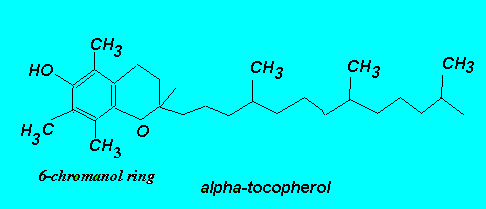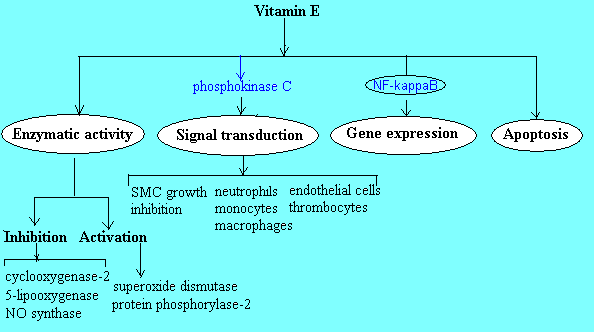|
Natural vitamin E is a mixture of tocopherols and tocotrienols (a, b, g, d) synthesized by plants. Chemically tocopherols consist of a chromanic ring and an aliphatic side chain (saturated for tocopherols and unsaturated for tocotrienols). There is no significant difference in antioxidant power between the various tocopherols. Vitamin E does not appear to have a specific plasma carrier protein as opposed to vitamins A and D. In plasma it is found in lipoproteins where it protects cholesterol and unsaturated fatty acids against
oxidative stress.
 Some of the biological functions of vitamin E are summarized below:
Some of the biological functions of vitamin E are summarized below:
- Major antioxidant nutrient; it slows down the aging process, which is partly caused by oxidative stress.
- Protects circulating cholesterol in LDL and membrane lipids in red blood cells against oxidative damage.
- Protects immunocompetent cells such as phagocytic cells against oxidative damage that occurs in infections (1).
- Prevents damage to informational macromolecules such as nucleic acids by scavenging free radicals (mainly oxygen reactive species) generated within cells.
- Modulates enzyme activity through specific interactions with enzymes and gene expression through interactions with regulatory proteins such as transcription factors. These actions of vitamin E involve a non-antioxidant type of mechanism that may be relevant in cardiovascular disease (2). The main effects of vitamin E at cellular and molecular level that involve a non-antioxidant mechanism are depicted in the figure below.

Tocopherols, particularly a-tocopherols, were shown to influence cellular processes such as signal transduction, gene expression and apoptosis. Vitamin E is involved in the modulation of signal
transduction by activating protein phosphorylase-2, which catalyzes the dephosphorylation of protein kinase C
(PKC). Thus, by dephosphorylation PKC becomes inactive and this in turn triggers a host of events such as the
arrest of smooth muscle cell growth, inhibition of superoxide ion production in neutrophils, monocytes, macrophages, inhibition of thrombocytes aggregation and inhibition of endothelin secretion by endothelial cels.
By inhibiting cyclooxygenase-2 and 5-lipooxygenase vitamin E is involved in the modulation of the inflammatory
response through decreased prostaglandin synthesis and the inhibition of interleukin-1b (a proinflammatory cytokine), respectively. Although the involvement of vitamin E in
transcription factor NF-kB activity inhibition ( NF-kB controls the expression of various genes involved in inflammatory response and cellular proliferation) has been
documented as shown by the inhibition of NF-kB activation in human T cells culture
containing a-tocopheryl acetate it is not clear whether vitamin E blocks directly
some of the key steps of NF-kB activation or acts through intracellular redox status
modulation. Redox status modulation is known to be a major determinant of NF-kB
activation.
- Interactions: vitamin E works best in cooperation with vitamin C and selenium.
- Health benefits: supplementation is useful in allergies, autoimmune disorders (lupus, rheumatoid arthritis), bacterial and viral infections, cardiovascular disease, diabetes, gum disease, skin disorders etc. In these conditions the general consensus is that vitamin E acts as a free radical scavenger but in
the cardiovascular disease it can also act in a non-antioxidant way as discussed above.
- Best food sources: vegetable oils (corn, sunflower (contains
a-tocopherol), olive, flaxseed), seeds, nuts, leafy vegetables, tomatoes.
References
1. Hughes, D.A. (1999) Proc.Nutr.Soc. 58(1) 79-84. Effects of dietary antioxidants on the immune function
of middle-aged adults.
2. Munteanu, A. et al. (2004) J.Cell.Mol.Med. 8(1) 59-76. Anti-atherosclerotic effects of vitamin E - myth or reality?
|


